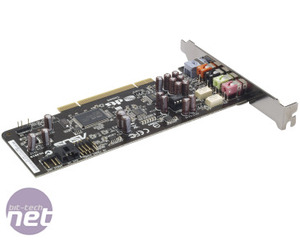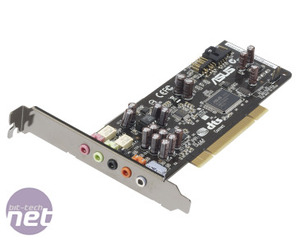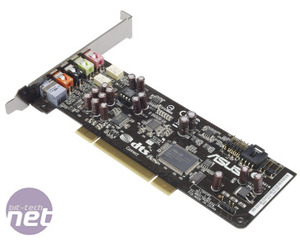Asus Xonar DS 7.1 PCI
Manufacturer: AsusUK Price (as reviewed): £35.83 (inc VAT)
US Price (as reviewed): $49.99 (ex tax)
Specifications
- Processor Asus AV200 (C-Media CMI-8788 OxygenHD)
- Memory None
- Interface 32-bit PCI
- Maximum Channels 8
- Bit-rate 24-bit
- Maximum Sample Rate 192KHz
- Inputs 3.5mm mini-jack mic/line in
- Outputs 4 x 3.5mm mini-jack analogue surround out, optical S/PDIF out
- Audio technologies DTS Interactive Encoder, DTS Neo:PC, DirectSound3D GX 2.5, EAX 2.0&1.0, DirectSound HW, DirectSound SW, A3D 1.0, OpenAL generic modes, 128 3D sounds processing capability (EAX5 software emulation), SoundFont, ASIO 2.0 driver support
- Extras half-height bracket, TOS-Link adaptor
At £36, the Xonar DS is the most affordable sound card in Asus's range. It's a low-profile PCI card, which is handy if you're short on PCI-E x1 slots, but not much use if you've got a recent motherboard with only a few PCI slots. Still, the short height means that the card can fit in small media PC cases.
The Xonar DS uses Asus's AV200 audio processor, a rebranded version of C-Media's CMI-8788 OxygenHD processor. Digital-to-analogue conversation, which plays a major part in the quality of the audio you get out of the 7.1 analogue outputs, is handled by a Wolfson WM8766G DAC for the front channels and a Wolfson WM8776S codec for the rear.
The latter also handles the analogue-to-digital conversion for the mic/line input. Oddly for such a cheap card, there’s a replaceable JRC 8017C op-amp on the front output, so audiophiles can make their own upgrades.
These components provide an analogue playback sample rate of up to 192KHz/24-bit and a recording rate of 96KHz/24-bit. The Xonar DS has the least impressive Signal-to-Noise ratio (SNR) of any of the cards in this test though, at 107dB on the output channels and 100dB on the input - this is still a respectably high-quality level of SNR, however. Five 3.5mm stereo mini-jacks on the back can be configured for either 7.1 or 5.1 audio, with one mic/line input. Alternatively, the output labelled ‘7.1 Rear’ doubles as an optical S/PDIF digital output.
The accompanying driver and software package for the Xonar DS isn't as fully-featured as those of Asus's more expensive cards. Most significantly, although the card can handle DTS stereo-to-surround-sound conversion, none of the Dolby surround sound processing is supported, so home cinema system builders should look elsewhere. The old EAX 5.0 environmental audio standard is supported via software emulation (as with all of the Xonar gaming sound cards), which is certainly convincing enough to get an enjoyable and immersive experience out of any games that support EAX. Positional audio on OpenAL, FMOD and DirectSound games also worked a treat.
Asus has provided low-latency Audio Stream Input/Output (ASIO) drivers with the Xonar DS. These are handy if you use audio capture or DJ software that uses ASIO drivers but, with its single 3.5mm line input, this isn't a serious musician's card. Its recording quality was clean, though.
Playback quality was excellent in all our stereo and 5.1 audio tests, with clear treble notes, a thundering bass and rich, balanced mid-tones. The warmth of the audio belies the card's low price.
Conclusion
Although it's not as feature-packed as the other two cards in this mini-roundup, the Xonar DS is a brilliant budget choice. If you want to use S/PDIF to output audio to a set of surround sound speakers, the Asus Xonar DX is a better option as it supports Dolby Digital, but the Xonar DS is still an great card considering the bargain price.- Sound Quality
- x
- x
- x
- x
- x
- x
- x
- x
- x
- -
- 9/10
- Features
- x
- x
- x
- x
- x
- x
- x
- -
- -
- -
- 7/10
- Value
- x
- x
- x
- x
- x
- x
- x
- x
- x
- -
- 9/10
- Overall
- x
- x
- x
- x
- x
- x
- x
- x
- -
- -
- 8/10

Asus Xonar DS

MSI MPG Velox 100R Chassis Review
October 14 2021 | 15:04













Want to comment? Please log in.